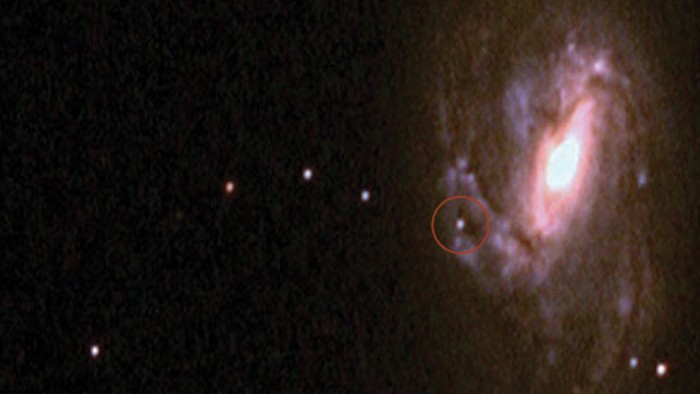 Natural Sciences
Natural Sciences
Cosmic Connections

You don’t have to go to NASA to have an otherworldly experience in UO physics research.
So says undergraduate Charity Woodrum, who, in fact, did go to NASA—she was at the space agency’s Marshall Space Flight Center in Alabama last summer for a 10-week research internship (see “Stellar Student,” p. 16).
But students fascinated by physics have scores of research opportunities at Oregon. Almost all of the department’s faculty manage or participate in large research programs, and most welcome undergraduates for their projects.
Those projects include working on and installing seismographs that monitor the Cascadia subduction zone, building and commissioning a robotic telescope at Pine Mountain Observatory and helping an international team of scientists obtain data at the Large Hadron Collider in Geneva, said Scott Fisher, the department’s director of undergraduate studies and public outreach coordinator.
UO physics majors “are deeply engaged in research at large and small facilities around the state, country and globe,” he added.
Woodrum is one of the students making waves in research here at the UO, working with similarly motivated and talented phys.ics undergraduates.
Over Memorial Day weekend, Woodrum and other undergraduate members of the astrophysics research group spotted an exploding, dying star in a galaxy 35 million light years away while on duty at the UO’s Pine Mountain Observatory near Bend. The observation helped the global scientific community confirm the supernova, which had been detected by astronomers in Australia just a few hours earlier.
The dying star was some eight to 50 times the mass of the sun.
“When we saw the picture come up on the monitor and saw the supernova clearly visible, it was extremely exciting,” physics major Lindsey Oberhelman said. “None of us students had done any observing before.”
Woodrum’s role was pivotal. Scientists had just learned of the possible supernova in a distant galaxy, so she encouraged the team to train the telescope there, just in case.
A Supernova on the First Run
Their instrument was the most modern telescope at the observatory: the state-of-the-art Robbins telescope, built with mostly off-the-shelf components and customized with UO staff- and student-designed hardware and software. The scope will eventually be operated from a control room on campus, said group leader Fisher.
“It was a goal of mine to image at least one supernova within the two years I have with the Robbins telescope, but I thought it was an improbable goal,” Woodrum said. “I definitely didn’t expect to see one in our first run.”
Fisher is committed to transforming the observatory into an instrument for undergraduate research. But his undergraduates are also probing a topic that has nothing to do with telescopes—understanding the evolution of galaxies.
Scientists trying to learn more about how galaxies are formed often concentrate on two types: “galaxy clusters,” which refers to a big group of them bound together by gravity, and “field galaxies,” which essentially have no neighbors. Comparing the two groups can lend insight into how they have evolved, Woodrum said.
The team, which works with images of galaxies taken by the Hubble Space Telescope, is collaborating with institutions from around the world. Those images show points of light that have traveled a mind-boggling distance to reach the Hubble—six billion light years, or roughly half the age of the universe.
After an initial analysis of the images was performed, Woodrum and the rest of the UO team inherited the results as a large and complex database of numbers. They have been responsible for plotting, visualizing and, most important, interpreting the data obtained with Hubble, the Gemini Observatory in Hawaii and other large telescopes.
Woodrum’s team found that at a given point in time, solitary galaxies tend to be younger than cluster galaxies. The latter evolve more quickly because the presence of neighbors creates a strong gravitational pull that accelerates activity—star formation, for example.
“When galaxies collide, a lot of stuff happens,” Woodrum said. “When one is alone and minding its own business (growth occurs) more slowly.”
It’s a simple, compelling scientific observation—but there’s nothing simple about the skills it takes to get there. To convert images from space into a verifiable find such as this, Woodrum relies heavily on mathematics and a command of multiple programming languages.
Woodrum has received an undergraduate research fellowship of $8,000 from the Oregon NASA Space Grant Consortium for the work. The consortium, a statewide network of universities, museums, researchers and more, promotes education in science, technology, engineering and math. Astrophysics work is demanding, Woodrum said, but the payoffs—unlike those galaxies she studies—are never far away.
“Every physics student gets to be in awe every day—and in research, even more so,” Woodrum said. “Most physics students love learning something new every day. But when you’re doing research on the evolution of a galaxy, you get to learn something new for humanity. That’s a whole new level.”
—Matt Cooper
Photo caption: In May, a team of UO undergraduates was among the first to spot an exploding, dying star in a galaxy 35 million light years away. Their observation helped the global scientific community confirm the supernova—circled in red—which had been initially detected just hours earlier.


 Twitter
Twitter Facebook
Facebook Forward
Forward